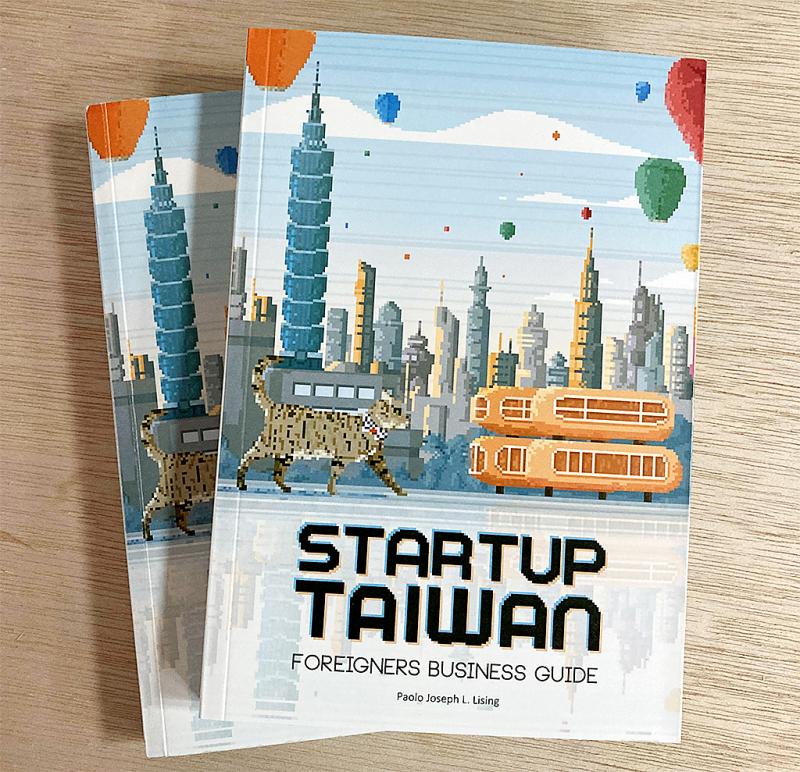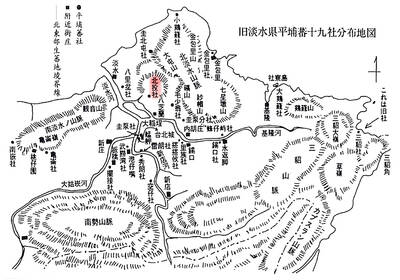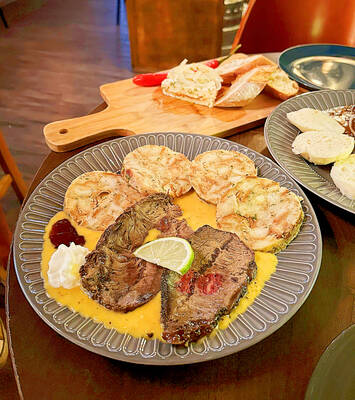Despite the unfortunate design decision of printing the entire book in tiny font on gray paper, Startup Taiwan: Foreigners Business Guide is an easy-to-follow, immensely detailed and thoughtful manual to starting your business in Taiwan.
While this reviewer’s eyes hurt a bit after reading it, I will definitely be coming back to this book if I ever launch my own venture here, as it boils down the official-speak and often confusing government Web sites to simple language and organizes them in a logical manner so one knows exactly what to do, from visas to permits to funding and subsidy options and Taiwanese business etiquette.
Author Paolo Joseph Lising is a Taiwan-based digital marketing expert who has gone through the trials and tribulations of entrepreneurship, and currently runs MillionDC.com, a learning platform for entrepreneurs.

The tone he uses in the book is personal and approachable, and although the English is slightly clunky in some places, it’s more than just a dry, robotic guide that walks potential business owners through the motions. This is Lising’s second publication on startups: Cyberpreneur Philippines was named a finalist under the Professions category at the Filipino 2016 National Book Awards.
Sure, despite the bureaucracy and usual barriers foreign entrepreneurs often complain about when navigating Taiwan’s startup world, much of this basic information can still be readily gathered through the Internet if one actually tries — including those on cultural sensitivity (consult a Taiwanese friend before deciding on your company name in Chinese!) and local business practices, such as guanxi (關係, connections), gift taboos and dinner etiquette.
But as British business owner Sam Crawford points out in the book, government-provided information is still “poorly laid out, hard to find, hard to decipher and seems to exist across a range of different sites.”
Lising makes it easy for the readers by putting all the information in one book while extensively listing each relevant agency and program with their contact information. He also provides thoughtful reminders for those going through the process, such as deadlines and pitfalls and so on.
The real meat of the book, however, are the interviews and case studies from officials, accountants, investors and entrepreneurs who share their advice, struggles and successes. These are peppered throughout the book to break the monotony.
The funding chapter is especially insightful. Not only does Lising comprehensively lay out the various avenues of receiving support, he asks different Taiwanese venture capitalists to share their criteria and decision-making processes when deciding to invest. He also asks foreign startups to comment on their experience with venture capitalists, so a full picture is presented.
The case studies chapter provides a nice mix of experiences, from a recognized startup that was rejected three times for government subsidy to one that got accepted into three Taiwanese accelerators. These interviewees present insightful information:
“In Taiwan, things have to be done in a certain sequence and it is not possible to do everything at once,” says an entrepreneur.
“You have to read through the government’s guidelines, and see how your startup can fit those requirements instead of convincing them [the judges] with why you think your company deserves the grant … You have to fit in their box,” warns a startup consultant.
While the first part of the book rosily paints Taiwan as a safe, liberal, expat-friendly haven with a high standard of living and a forward-thinking government that encourages and supports digital startups and foreign talent, the second half gets to more of the bureaucracy, conservatism and other problems that have deterred foreign entrepreneurs. It is one reason why such books are still being written.
These start to emerge with the case studies that culminate in Chapter 8, which contains input from foreigners, including the American Chamber of Commerce in Taipei, on how the government can improve its policies to build a robust and more desirable environment for foreign startups. This part is quite pointed, and highlights the realities that prevent Taiwan from becoming a premier destination for foreign talent, and is worth the read even for non-startup hopefuls.
From unrealistic financial requirements from the government to outdated banking practices, unclear laws and confusing tax rules, this part sheds light on why the nation is still not where it needs to be despite its favorable conditions compared to the rest of Asia. Taiwan sure has the tools, talent and environment, but certain political and cultural factors hold it back, and that obviously needs to change.
Without getting too preachy, Lising wraps the book up with tips and lessons from his own extended experience in Taiwan, rounding out this helpful and immensely informative reference guide. If there is a reprint, though, the publishing company should absolutely make the layout easier on the eyes.

Seven hundred job applications. One interview. Marco Mascaro arrived in Taiwan last year with a PhD in engineering physics and years of experience at a European research center. He thought his Gold Card would guarantee him a foothold in Taiwan’s job market. “It’s marketed as if Taiwan really needs you,” the 33-year-old Italian says. “The reality is that companies here don’t really need us.” The Employment Gold Card was designed to fix Taiwan’s labor shortage by offering foreign professionals a combined resident visa and open work permit valid for three years. But for many, like Mascaro, the welcome mat ends at the door. A

The Western media once again enthusiastically forwarded Beijing’s talking points on Japanese Prime Minister Sanae Takaichi’s comment two weeks ago that an attack by the People’s Republic of China (PRC) on Taiwan was an existential threat to Japan and would trigger Japanese military intervention in defense of Taiwan. The predictable reach for clickbait meant that a string of teachable moments was lost, “like tears in the rain.” Again. The Economist led the way, assigning the blame to the victim. “Takaichi Sanae was bound to rile China sooner rather than later,” the magazine asserted. It then explained: “Japan’s new prime minister is

NOV. 24 to NOV. 30 It wasn’t famine, disaster or war that drove the people of Soansai to flee their homeland, but a blanket-stealing demon. At least that’s how Poan Yu-pie (潘有秘), a resident of the Indigenous settlement of Kipatauw in what is today Taipei’s Beitou District (北投), told it to Japanese anthropologist Kanori Ino in 1897. Unable to sleep out of fear, the villagers built a raft large enough to fit everyone and set sail. They drifted for days before arriving at what is now Shenao Port (深奧) on Taiwan’s north coast,

Divadlo feels like your warm neighborhood slice of home — even if you’ve only ever spent a few days in Prague, like myself. A projector is screening retro animations by Czech director Karel Zeman, the shelves are lined with books and vinyl, and the owner will sit with you to share stories over a glass of pear brandy. The food is also fantastic, not just a new cultural experience but filled with nostalgia, recipes from home and laden with soul-warming carbs, perfect as the weather turns chilly. A Prague native, Kaio Picha has been in Taipei for 13 years and